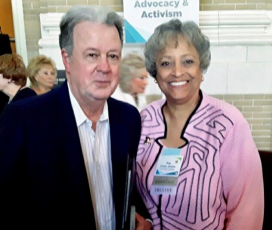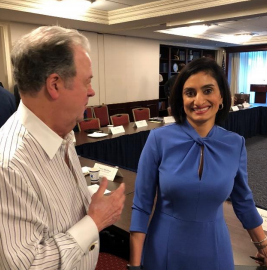2019 Third Quarter in Review
During the third quarter, the Goodman Institute joined with the Heritage Foundation to develop a health reform plan for the Trump administration, developed a solution for surprise medical bills, explained what Republicans and Democrats want to do with Medicare and created a new environmental blog.
During the third quarter, the Goodman Institute joined with the Heritage Foundation to develop a health reform plan for the Trump administration, developed a solution for surprise medical bills, explained what Republicans and Democrats want to do with Medicare and created a new environmental blog.
Think Tanks Unite Behind a Health Plan – Finally!
The plan was prepared for the Trump administration by John C. Goodman (father of Health Savings Accounts) and Marie Fishpaw (Heritage Foundation) and published by National Review Online. It features such patient-friendly ideas as portable health insurance and doctor consultations by means of phone, email and Skype.

The plan, which relies heavily on changes the Trump administration has already been implementing, would make it easier for patients to have an inexpensive concierge relationship with their doctors – getting access to care at nights and on weekends without going to hospital emergency rooms.
“We have cut the Gordian Knot that has held back conservative health reform for three decades,” says Goodman.
“Most people in hospital emergency rooms don’t need to be there,” he says. “They can be examined in the comfort of their own homes using a cell phone with an app or two.”
The plans stress the idea of empowering patients – by giving them the same opportunities they have in other markets.
“Medicine needs to step into the 21st century,” says Goodman.
Five Reform Ideas
Health reform should make it easy as possible for people to access innovations such as:

JOHN GOODMAN TALKS WITH HERITAGE FOUNDATION PRESIDENT KAY JAMES.
- Personal and portable health insurance that travels with people from job to job and in and out of the labor market.
- Round-the-clock access to physicians by phone, email, and Skype.
- Telemedical “doctor visits” from home – avoiding traffic, long waits, and trips to emergency rooms.
- Centers of excellence specializing in chronic health conditions and actively competing for patients.
- Accounts owned and controlled by patients who are willing to manage their own care, including most forms of chronic care and even routine surgery.
Surprise Medical Bills

SENATOR BILL CASSIDY (R-LA) AND JOHN GOODMAN DISCUSS SURPRISE MEDICAL BILLS.

JOHN GOODMAN WITH SEEMA VERMA, WHO DIRECTS THE MEDICARE AND MEDICAID PROGRAMS.
We Have a New Environmental Blog
The Liberty, Ecology and Prosperity blog is about appreciating and protecting the environment using the tools of economics. The blog manager is Jane Shaw Stroup, a former senior fellow of the Property and Environment Research Center (PERC). John Baden, father of the New Resource Economics, is the lead-off blogger. (See the side bar.)


What you will learn from recent posts:

JANE SHAW STROUP IS THE BLOG MANAGER.

JOHN BADEN IS THE FATHER OF THE NEW RESOURCE ECONOMICS.
- On extreme weather: Hard data, collected over decades, show no increase in the frequency or severity of hurricanes over the past century. Also, droughts are not more common, severe, or of greater length.
- On Amazon fires: They are mostly on farms and ranches; there is no increase in forests burning; the number of fires in 2019 is only 7% higher than the average for the past 10 years; and news coverage has been inundated with fake photos.
- On the international threat to food production: Global crop production has been setting new records virtually every year.
- On the threat of one million species extinctions: Over 500 years there have been 800 known extinctions; the number peaked in the nineteenth century and has been declining since.
- On Greenland ice melting: After a very brief period (a few days) of strong melt, conditions have returned to normal.
- Are global warming skeptics dying off? (Yes.)
What Would Medicare for All Mean? Bernie Sanders, dozens of other Democratic candidates running for office this year, and almost everybody on the political left, think that Medicare is government insurance and that it is completely different from private insurance. This conception turns out to be wrong. One-third of all seniors are enrolled in insurance plans offered by Humana, Cigna, UnitedHealth care and other private insurers under the Medicare Advantage program. This is one of ten surprising facts readers can discover in a new Brief Analysis by John Goodman. Briefing on Capitol Hill Although President Trump often promises he will produce a health plan in the future, his administration has already instituted fairly radical reforms that have received very little attention in the mainstream media and even in the health care media. In September, John Goodman conducted a Capitol Hill briefing on what Trump has already achieved and what Congress needs to do to complete the reform. He was joined by Brian Blaise, formerly special assistant to the president for health policy; Grace-Marie Turner, president of the Galen Institute and leader of the Consensus Group; and Heritage Foundation health policy expert Nina Schaefer. Among the reforms discussed were personal and portable health insurance and new advances in telemedicine. Outreach

JOHN GOODMAN WITH RALPH WEBER, CEO OF MEDIBID, AT THE AMERICAN LEGISLATIVE EXCHANGE COUNCIL.
